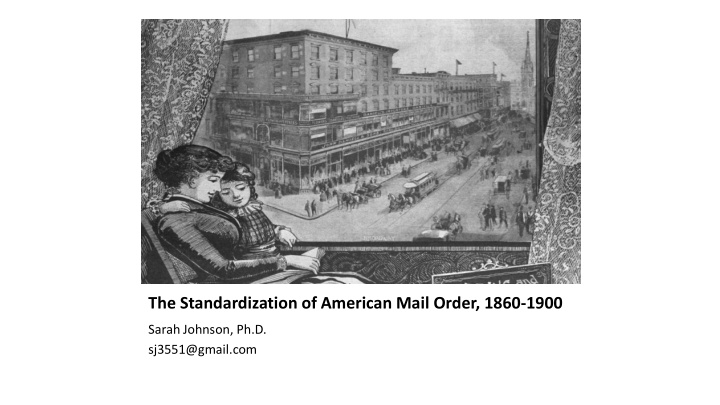



The Standardization of American Mail Order, 1860-1900 Sarah Johnson, Ph.D. sj3551@gmail.com
Addressed to John Larwill, Wooster, Ohio, 1c stamp Warshaw collection, circulars were folded, addressed on backs; 1847 Stamps issued to pay for postage; 1855 Compulsory prepayment of postage; 1861 4 lb pkg admitted, .01/oz under 1500 miles, .02/oz over 1500 miles; 1863 3 prepaid classes of mail
Pkgs less than 4 lbs allowed in mail 2/27/1861; Ralph Hower “to stimulate sales…Macy as early as 1861 advertised gloves to be delivered by mail (63 ct/pair; 69ct by mail) NY Herald ads 1/21/1861; 11/7/1861
B. Altman receipt for gloves to Nassau, NY
A.T. Stewart Catalog Cover detail, ca. 1862 In 1863, mail is divided into 3 classes, prepaid, with money orders coming in 1864
James McCreery ad in Harper’s Bazar, 10/2/1869 p. 639, specifies price list before the use of the term catalogue in 1875
Lord & Taylor ad in Harper’s Bazar, 4/22/1871 p. 255, specifies sending orders by mail, COD, or by express. The 3 prepaid classes of mail were revised in 1872, 1873, 1874, 1876, 1879; by 9/19/1874, AT Stewart, “the recent change in the Postal laws…enable our friends, customers, and strangers at any point in the US or territories to purchase dry goods.”
Macy’s catalog 1877—lack of illustrations, reduced size Technologies exist to illustrate catalogs, especially w/print runs twice a year but the marketing acumen doesn’t evolve until the late 1870s. Retailers insisted on the 2 nd class rate for catalogs; they grew in size from mid-1870s (30-40 pp), to 150-180 pp in the 1880s and hundreds of pages in 1890s to compete with direct marketers.
Catalog Covers, the Middle Class & Stock Imagery Bronner & Co, Buffalo, NY 1888
“Orders by mail carefully and promptly attended.”
American Express’s Personal Shopping Service An order form from July 1878, “…the leading merchants of large cities, to fill orders at a discount off retail rates, which rates would in most cases be paid by the purchaser if made in person or ordered through the mail. Such discount will in all cases be allowed on cost of purchase, the Company making no charge except for carriage of the property.
Women’s magazine format, Spring 1882 The first S&C Quarterly published Spring 1882, p. 30 “…Not so many yers ago, ladies living away from the great centres of trade, were at least a season behind in the style of their garments. Now they need no longer wait…this shopping by mail is the practical result of overcoming space and time…at .50/yr, the subscription price of the 1/4ly covers but a small fraction of the cost of publishing & mailing.”
12/17/1878 Stern’s to Consumer post card
Verso, Notification of shipment of package
R.H. White’s 1883 mail order department “a large room where all retail orders sent by mail are filled—receipt of letters averaging one thousand per day,” difficult to quantify though used in marketing rhetoric, Jordan Marsh cited a 100% annual increase in mail order for ten consecutive years in Fall 1881 catalog. By 1895, Kaufmann’s in Pittsburgh specified 43,000 orders ranging from .10-hundreds of dollars.
Hill’s Manual of Social & Business Forms, 1882 p. 86, Mail ordering covered in etiquette books
Lord & Taylor’s 1879 letter template
Jordan, Marsh’s illustration of the mail order process Jordan, Marsh, S1884, ifc“To our patrons is respectfully dedicated this, the Spring number of the eighth volume of our semi-annual dry goods catalogue. Like its predecessors, it has been designed and compiled for the benefit and assistance of our out-of-town patrons, whose names out-number the population of the majority of the large cities in the United States.
Postal legislation & Direct Marketing Assn. The debate continues…
Recommend
More recommend